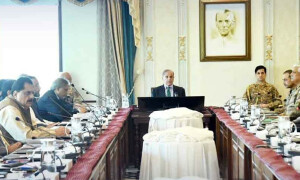Rising world commodity prices, Covid variants: Finance ministry highlights downside risks to economic outlook
ISLAMABAD: The Finance Ministry has highlighted that there are some downside risks to the outlook of the economy associated with rising international commodity prices, new variants of virus, and geopolitical dynamics especially the post-August 15 scenario in Afghanistan.
The finance ministry in its monthly economic update released for the month of September 2021 noted that growth-oriented policies of the government would take the economy on higher, inclusive and sustainable growth in fiscal year; however, there are some downside risks to the outlook associated with rising international commodity prices, new variants of virus, and geopolitical dynamics especially post-August 15 scenario, emerged in Afghanistan.
The ministry said that “short-term sustainability of the economic growth requires that the trade deficit remains manageable”.
Pakistan’s economy is currently on a higher growth path and for long-term sustainable economic growth the expansion of domestic production stands vital as value-added creation would generate income that can be spent on consumption and investment.
This can be managed by appropriate long-term structural policies, which are being implemented by the government.
The revival of economic activities domestically has surged imports bills mainly due to an increase in raw materials for consumer and capital goods especially in the last three months.
The substantial rise in international commodity prices is the major reason of increase in import bills, which has put pressure on the Pakistani rupee.
Further, changing geo-political situation is also building pressure on domestic production and the money market.
Commodity prices worldwide: Increase will have inflationary implications for country: ministry
The government’s efforts at fiscal consolidation is likely to continue in the current fiscal year; however, development spending has been increased significantly for the on-going fiscal year with a view to give a further boost to economic growth.
Therefore, with higher development and Covid-19-related spending, overall expenditures may likely come under pressure.
The fiscal deficit in terms of the GDP contained at 0.4 percent (Rs237.8 billion) in July 2022 against 0.5 percent (Rs211.6 billion) in the comparable period of last year, while the primary balance remained in surplus and stood at Rs71.7 billion (0.1 percent of GDP) against Rs55 billion (0.1 percent of GDP) during the period under review.
In July, 2022 expenditures under PSDP grew by 72 percent to Rs25.3 billion against Rs14.7 billion in the same period of last year.
On revenue side, the FBR tax collection grew by 47.4 percent to Rs442.3 billion in the month of August, and tax collection has surpassed the target by Rs94 billion set for the month of August.
The revival of economic activities all over the world has increased the prices of commodities unprecedentedly, thus, putting inflationary pressure globally.
The revival of economic activities significantly domestically increased imports mainly due to an increase in raw materials for consumer and capital goods.
In September, month-on-month inflation may decelerate from second round effects of previous increase in international commodity prices and currency depreciation.
Inflation rate in September 2021 is expected between 7.5 to 8.4 percent.
In real sector, Finance Ministry said that the overall cotton production is estimated at 8.5 million bales during fiscal year 2022 showing an increase of 20 percent compared to 7.1 million bales last year.
In Sindh, production of cotton is expected to reach 3.5 million bales compared to 1.9 million bales last year.
While in Punjab, cotton production is estimated to be 4.5 million bales.
Global edible oil trends: Tarin for reflection of price decline in domestic prices
Sugarcane production may increase during fiscal year 2022, mainly, due to an increase in cropped area, effective and timely crop management activities.
On agriculture inputs side, the situation remained favourable.
According to the Pakistan Automotive and Manufacturing Association (PAMA), farm tractors production increased by 38.7 percent to 9,263 in Jul-Aug 2021-22 and its sales also witnessed an increase of 18.5 percent to 6,457, compared to the same period last year.
Most importantly, agriculture credit disbursement target set at Rs1,700 billion for 2021-22, 13.3 percent more than last year.
During July-August 2022, the agriculture credit disbursement increased by 7.5 percent reached Rs171.6 billion compared to disbursement of Rs159.7 billion over the same period last year.
The urea offtake during July 2021 was 622,000 tonnes showing an increase of 8.1 percent over July 2020.
The closure of industrial activities during Eid-ul-Azha holidays and monsoon rains spread over 15 days also hampered growth momentum.
Meanwhile, some revision in the previous data (FY2021) has also been observed, which has caused a low pace in LSM growth during July fiscal year 2022 as 11 out of 15 sub-sectors of LSM have witnessed positive growth.
Automobile shows a massive growth of 44.62 percent, wood products grew by 24.20 percent, chemicals by 13.61 percent, iron and steel products by 11.34 percent, and leather products by 11.72 percent.
Car production and sale increased by 111.7 percent and 92.8 percent, while tractor production and sale increased by 38.7 percent and 18.5 percent, respectively.
Total oil sales increased by 22 percent to 3.9 million tonnes in Jul-Aug FY2022 (3.3 million tonnes last year).
In August FY2022, total cement dispatches increased by 22.8 percent to 4.3 million tonnes (3.5 million tonnes last year).
Based on recent performance and the government’s proactive measures, it is expected that the industrial sector will follow an upward trend and achieve growth target.
Copyright Business Recorder, 2021


























Comments
Comments are closed.